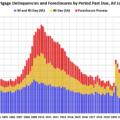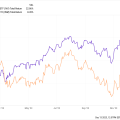Good Morning. The Bank of Japan started its rate-rising cycle and announced a slowdown in buying bonds. The yen jumped, and Japanese banks are loving it. And in another sigh of relief: Meta’s earnings were just fine. Revenue rose 22 per cent. If we can get past Apple and Amazon tomorrow without an accident, the ageing bull market will be clear to run a bit further. What risks are we missing? Email us: robert.armstrong@ft.com & aiden.reiter@ft.com.
It’s all going according to plan
We got what we expected. The Federal Reserve did not cut rates but signalled an important change in posture: from leaning into the price stability mandate, to a balance between prices and employment. This opens the way to lower rates if the next few inflation reports co-operate.
Seeing the shift did not, as it often does, require a careful parsing of answers in chair Jay Powell’s press conference. It was all there in the statement. In the June statement, it was “the unemployment rate has remained low”; yesterday, it was “the unemployment rate has moved up”. “Modest further progress” on inflation became “some further progress”. Most plainly of all, a committee that was “highly attentive to inflation risks” has become “attentive to the risks to both sides of its dual mandate”.
The two-year Treasury yield — the indispensable friend of Fed watchers — confirmed this posturing was a dovish relief, gliding down by eight basis points.
The tenor of the questions in the press conference confirmed there are now two types of people in the economic punditocracy. First there are those who believe the recent loosening (softening? weakening? take your pick) in the job market is normalisation, as the pandemic slips further into the background. And then there are those who think it could be the early stages of something worse. Those in the latter camp pressed Powell on the lagged effects of tight monetary policy and whether the Fed risks cutting too late.
Powell is in the first camp, though he emphasised he is being watchful. In a telling answer, he said the job market looks a lot like it did on the eve of the pandemic: strong, but not a likely source of inflationary pressure. Unhedged, for what it’s worth, thinks the evidence supports Powell’s view: the economy appears quite firm, so a sharp cooling in the labour market seems unlikely.
In emphasising the strength of the economy, Powell referred to real final sales to private domestic purchasers, a measure of demand that was up 2.9 per cent in the second quarter. That is impressive. But there is a nagging fear, even for sanguine people like Unhedged. How long will private demand hold up when consumption growth is running ahead of income growth, as it recently began to do? And when it starts to stutter, will unemployment begin to rise?

Bitcoin and the presidential race
Unhedged has managed to avoid writing about cryptocurrencies for almost a year now. The 2024 presidential race has pulled us back in. Recent proclamations by Donald Trump to make America the “bitcoin superpower of the world” and reporting that Kamala Harris is pursuing détente with crypto billionaires makes us wonder, once again, what it is that crypto wants from the government?
The somewhat odd answer, given the industry’s rebellious self-image, is regulation. Regulatory uncertainty has been a headwind. Securities and Exchange Commission lawsuits against Binance, Circle and other exchanges have made it clear that the risks of ambiguity are higher than the costs of oversight. Just as important, the right regulations could bring legitimacy to an industry that, ultimately, just wants to sell more product.
There are two main areas of problematic uncertainty: stablecoins and exchanges.
A stablecoin, for those happy people who have never found out, is an intermediary between fiat currencies and cryptocurrencies. Users swap their fiats for stablecoins, which they can then use to buy crypto assets on exchanges. The stablecoin providers park the fiat in safe, liquid assets such as Treasury bills, keeping the yield for themselves. If that sounds like a nice business, you would be right; according to yesterday’s earning report, big stablecoin Tether made $5.2bn in profits for the first half of 2024 on $118bn of reserves.
So stablecoins such as Tether and USDC are somewhere between a payment processor and a money-market fund. But the lack of regulatory clarity has gotten some into trouble with the SEC and the states.
The US does not have a federal electronic money policy, so stablecoins and payment processors are registered at the state level and do not have clear guidelines on reserve ratios. And they cannot park deposits in the Federal Reserve.
Timothy Massad, former commissioner of the Commodity Futures Trading Commission (CFTC), told Unhedged:
I would like to see federal regulation for stablecoins and payment processors. And [we should be] open to the idea of payment firms having accounts at the Fed, but they would need to meet certain clear standards.
The industry wants to have their cake and eat it too: softer regulatory standards than typical financial institutions, with the legitimacy and marketability of a regulated institution such as a money-market fund.
On the exchanges, crypto has been in the middle of a territorial conflict between the SEC and the CFTC, turning on whether it is a security or a commodity (see previous Unhedged takes here and here). There are arguments for both. The crucial takeaway is the crypto industry is de facto governed by the SEC, and they would prefer to be de jure regulated by the CFTC. From Hilary Allen at American University:
The legislative proposals that the industry is gunning for would carve them out from securities law, and place them under the much smaller CFTC. A lot of these crypto providers are “vertically integrated”, meaning that they are both the broker/dealer and the exchange, and that allows them to make money on the blockchain — which is an otherwise clunky technology. If they are governed as a security, they would have to give up that competitive advantage.
The SEC’s job is in part to eliminate the information asymmetry between issuers and buyers of securities. The CFTC governs commodities, where there is less potential for asymmetric information. CFTC regulation is less likely, in short, to constrain the conflicts which are rife in the crypto industry.
Bills currently in Congress are aligned with this vision. The Financial Innovation and Technology for the 21st Century Act protects stablecoins from CFTC and SEC oversight, and puts the exchanges under the jurisdiction of the CFTC. It passed the Republican controlled house with a bit of bipartisan support, but Democrats have not introduced it in the Senate.
Trump’s recent pro-crypto rhetoric doesn’t change the picture. A lax regulatory environment was expected under a Republican administration. Joe Biden stepping down and Kamala Harris stepping in, however, has given the industry a rare opportunity to get Democratic buy-in.
It is ironic that the sector that prided itself on being an alternative to a rotten financial system is gagging to be part of the financial establishment. But the establishment is where the, ahem, real money is.
(Reiter)
One good read
“Consumers appear more picky than panicky.”
FT Unhedged podcast

Can’t get enough of Unhedged? Listen to our new podcast, for a 15-minute dive into the latest markets news and financial headlines, twice a week. Catch up on past editions of the newsletter here.


